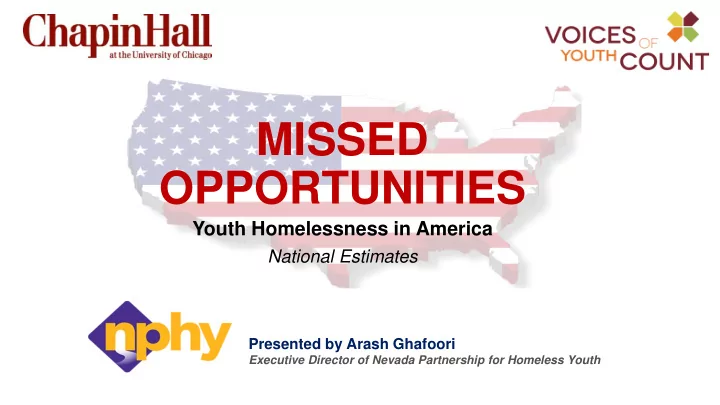

MISSED OPPORTUNITIES Youth Homelessness in America National Estimates Presented by Arash Ghafoori Executive Director of Nevada Partnership for Homeless Youth
Youth Homelessness in America • During 2016 and 2017, a national survey-based study was conducted by researchers from Chapin Hall at the University of Chicago and Voices of Youth Count to discover the prevalence of youth homelessness in America. • Missed Opportunities is the first study of its kind to evaluate the scope of youth homelessness on a national scale, using a broad definition of youth homelessness from those who reported couch-surfing to those who have experienced “literal homelessness” such as living on the streets or in shelters. • 26,161 people participated in the survey, including households with youth from ages 13 to 25 and individual youth ages 18-25 who have experienced homelessness. Follow-up interviews with a random sample of 150 people who reported any youth homelessness were also conducted for more information. • The study ( Prevalence and Correlates of Youth Homelessness in the United States) was also published by the Journal of Adolescent Health in January 2018.
Five Major Discoveries 1. Youth homelessness is a broad and hidden challenge • About 1 in 30 adolescents experience homelessness over a year’s time; of these adolescents, ¾ were “literally homeless” and ¼ couch-surfed. • About 1 in 10 young adults experience some form of homelessness each year; of these young adults, about 50% couch-surfed while 50% were “literally homeless.” 2. Youth homelessness involves diverse experiences and circumstances • 72% of “literally homeless” youth had also stayed with others while unstably housed. • 29% of youth surveyed reported substance abuse issues, and 69% suffered mental illness.
Five Major Discoveries (continued) 3. Prevention and early intervention are essential • 50% of youth who were homeless within the past year were homeless for the first time. • The majority of youth interviewed experienced housing instability during their childhood. 4. Youth homelessness affects urban and rural youth at the same levels • In predominantly rural counties, 9.2% of young adults and 4.4% of adolescents were homeless • In predominantly urban counties, 9.6% of young adults and 4.2% of adolescents were homeless
Five Major Discoveries (continued) 5. Some youth are at greater risk of experiencing homelessness • Ethnic minorities are over represented amongst homeless youth, with African American youth 83% more likely to experience homelessness and non-White Hispanic youth 33% more at-risk. • Lesbian, gay, bisexual, and transgender (LGBT) youth had a 120% higher risk of experiencing homelessness than youth who identified as cisgender or heterosexual. . • Young parents, especially unmarried parents, were 3x more likely ( 200% ) to experience homelessness than their non-parenting peers. • Youth who did not complete high school were 346% at higher-risk of experiencing homelessness. • About 1/3 of homeless youth had former experiences with the foster care system and roughly half had been in juvenile detention or corrections.
All Things Considered On November 15, 2017, National Public Radio (NPR)’s All Things Considered program featured a discussion about major findings in the Missed Opportunities report and how youth homelessness affects the Southern Nevada community. “We really need to dial back and be focused more on prevention. There are certain subsets of homeless youth that really require culturally sensitive and specifically tailored services.” https://www.npr.org/sections/ed/2017/11/15/564370605/new-study-finds-that-4-2-million-kids-experience-homelessness-each-year
Recommendations • Conduct national estimates of youth homelessness biennially. • Fund housing, services, and outreach targeted to homeless youth to the scale of need, accounting for youth with specialized needs. • Build up prevention efforts for systems-involved youth (those enrolled in schools, child welfare, and juvenile justice systems). • Tailor programs and services to fit the diverse needs of homeless youth (especially those most deemed at risk). • Develop strategies to address the disproportionate risks amongst specific subpopulations (LGBT, minorities, parenting youth, etc.)
More Information • To read the report or one-page brief, please visit: https://www.chapinhall.org/voyc http://voicesofyouthcount.org/brief/national-estimates-of-youth-homelessness/ • In the future additional research briefs are scheduled to be released using this data, covering topics such as youth count lessons, rural youth homelessness, pregnant and parenting youth homelessness, LGBT youth and homelessness, and more. • Join Voices of Youth Count’s email list for updates: http://voicesofyouthcount.org/join-voices-of-youth-count/
Recommend
More recommend